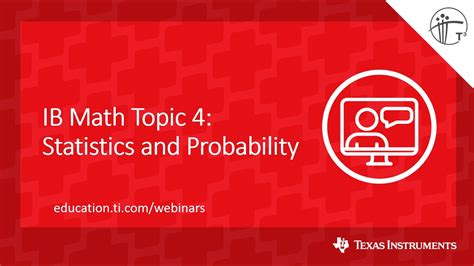Introduction

Statistics is a fundamental component of mathematics that plays a vital role in various fields, including economics, psychology, and medicine. It provides the tools to collect, organize, analyze, and interpret data, enabling us to make informed decisions and draw meaningful conclusions. IB Math Topic 4 Statistics delves into the concepts of descriptive statistics, probability, and inferential statistics, empowering students with a solid foundation in data analysis and probability theory.
Key Concepts in IB Math Topic 4 Statistics
Descriptive Statistics
Descriptive statistics summarize and describe the characteristics of a data set. This includes:
- Measures of Central Tendency: Mean, median, and mode, which provide an overview of the average or typical values in a data set.
- Measures of Dispersion: Range, variance, and standard deviation, which indicate how spread out the data is.
- Graphical Representations: Histograms, box plots, and scatterplots, which visually represent the distribution and relationships within a data set.
Probability
Probability theory studies the likelihood of events occurring. This includes:
- Probability Models: Theoretical models used to predict the probability of events, such as binomial, Poisson, and normal distributions.
- Conditional Probability: The likelihood of an event occurring given that another event has already occurred.
- Independent Events: Events whose occurrence is not influenced by each other.
Inferential Statistics
Inferential statistics draws conclusions about a population based on a sample. This includes:
- Hypothesis Testing: A procedure used to test whether a hypothesis about a population parameter is supported by the data.
- Confidence Intervals: A range of values within which the true population parameter is likely to lie.
- Sampling Methods: Random, stratified, and systematic, which ensure that the sample is representative of the population.
Importance of IB Math Topic 4 Statistics
Statistics has numerous applications across diverse fields:
- Market Research: Collecting and analyzing data to understand consumer preferences and market trends.
- Healthcare: Evaluating the effectiveness of medical treatments and predicting disease outbreaks.
- Finance: Modeling financial markets, managing risks, and predicting stock prices.
- Education: Assessing student performance and identifying areas for improvement.
- Environmental Studies: Gathering and interpreting data on climate change, pollution, and biodiversity.
Benefits of IB Math Topic 4 Statistics
- Data-Driven Decision-Making: Enables you to make informed decisions based on evidence and analysis.
- Critical Thinking: Develops your ability to analyze and interpret data, identify patterns, and solve problems.
- Communication Skills: Improves your ability to communicate data and insights effectively.
- Career Opportunities: Statistics is in high demand in various industries, providing ample career opportunities.
- Problem-Solving: Enhances your ability to solve real-world problems by applying statistical techniques.
Step-by-Step Approach to IB Math Topic 4 Statistics
1. Collect the Data: Determine the data you need and collect it through surveys, experiments, or observations.
2. Organize the Data: Clean, sort, and summarize the data using frequency tables, histograms, and box plots.
3. Analyze the Data: Determine the measures of central tendency, dispersion, and probability, and identify any patterns or trends.
4. Interpret the Data: Make inferences about the population based on the sample data, considering sampling methods and confidence intervals.
5. Communicate the Results: Present your findings in written form, using tables, graphs, and statistics software.
Applications of IB Math Topic 4 Statistics
The applications of IB Math Topic 4 Statistics are endless:
- Machine Learning: Combining probability theory and statistical models to create algorithms that learn from data.
- Data Visualization: Creating compelling visual representations of data to facilitate understanding and decision-making.
- Predictive Modeling: Using statistical models to predict future events, such as weather patterns or financial market trends.
- Risk Assessment: Evaluating the likelihood of negative events and implementing measures to mitigate risks in areas such as finance and healthcare.
- Quality Control: Using statistical techniques to monitor and improve the quality of products and services in manufacturing and other industries.
Tables for IB Math Topic 4 Statistics
Table 1: Measures of Central Tendency
| Measure | Formula | Interpretation |
|---|---|---|
| Mean | x̄ = Σx / n | Average value of the data set |
| Median | Value at the middle of the data set, when arranged in order | Divides the data set into two equal halves |
| Mode | Value that occurs most frequently in the data set | Represents the most common value |
Table 2: Measures of Dispersion
| Measure | Formula | Interpretation |
|---|---|---|
| Range | Maximum value – Minimum value | Indicates how spread out the data is |
| Variance | Σ(x – x̄)² / (n-1) | Average of the squared differences from the mean |
| Standard Deviation | √Variance | Indicates the average distance from the mean |
Table 3: Probability Distributions
| Distribution | Formula | Parameters |
|---|---|---|
| Binomial | P(X = k) = (n! / k!(n-k)!) * p^k * (1-p)^(n-k) | Number of trials (n), probability of success (p) |
| Poisson | P(X = k) = (λ^k * e^(-λ)) / k! | Mean (λ) |
| Normal | P(X ≤ x) = (1 / √(2πσ^2)) * ∫(-∞)^x e^(-(x-μ)^2 / (2σ^2)) dx | Mean (μ), Standard Deviation (σ) |
Table 4: Hypothesis Testing
| Hypothesis | Null Hypothesis (H₀) | Alternative Hypothesis (H₁) |
|---|---|---|
| One-Sample Mean | μ = μ₀ | μ ≠ μ₀ |
| Two-Sample Mean | μ₁ – μ₂ = 0 | μ₁ – μ₂ ≠ 0 |
| One-Sample Proportion | p = p₀ | p ≠ p₀ |
| Two-Sample Proportion | p₁ – p₂ = 0 | p₁ – p₂ ≠ 0 |
Conclusion
IB Math Topic 4 Statistics is an essential component of mathematics that provides students with the tools to collect, organize, analyze, and interpret data. It develops critical thinking, problem-solving, and decision-making skills, which are invaluable in various fields and careers. By understanding the concepts of descriptive statistics, probability, and inferential statistics, students can make informed decisions, draw meaningful conclusions, and contribute to data-driven decision-making in the modern world.
